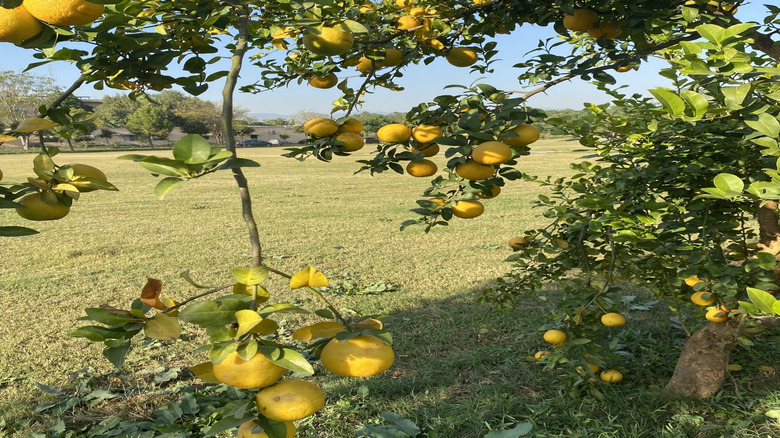Why You Should Consider Growing A Hybrid Fruit Tree In Your Backyard
Have you ever picked up a piece of fruit from the grocery store only to find it tastes bland? Perhaps you are fighting fruit tree pests that ruin your backyard harvest. Many gardeners would love to grow fruit trees, but they worry about the challenges that come with growing them — whether that be space requirements, finicky care needs, or hardiness concerns. The solution to many of these problems is a hybrid fruit tree. Growing a hybrid fruit tree in your backyard can make your life simpler. They're typically easier to grow, hardier, and more productive than traditional fruit trees.
Plant breeders deliberately cross two fruit tree species or cultivars to create a new variety — a hybrid — that inherits the most beneficial characteristics of its parent plants. This kind of cross-pollination can happen naturally, but human intervention produces fruit tree varieties faster and with targeted improvements. Choose some of these somewhat uncommon fruit trees to grow in your garden, and you're more likely to get larger yields of higher-quality fruit over many years. The ability of hybrid fruit trees to withstand common diseases and fend off pests also makes them a great lower-maintenance choice for home gardeners.
Plant a hybrid fruit tree for the unique flavors
Gardeners who plant hybrid fruit trees — or any fruit trees, for that matter — are usually hoping for better tasting fruit than they can get in-store. Breeders pick the parent species and cultivars with this in mind. The fruit on hybrid plants often has more natural sugars than non-hybrids — it's sweeter with more complex flavors, and may even have more nutrients. The Dapple Dandy pluot (Prunus x 'Dapple Dandy'), which thrives in USDA Hardiness Zones 5 to 9, is a popular summer-harvest hybrid. The fruit is sweet like an apricot, but it has firm skin like a plum. Other interesting hybrids include the nectaplum, a nectarine and plum mix suitable for growing in Zones 6 to 10, and the Sugar Twist pluerry (Prunus x 'Sugar Twist'), which bears fruit that tastes candy-like and is hardy in Zones 6 to 9.
Probably the most famous example of a hybrid fruit tree is the Meyer lemon (Citrus x meyeri), which is a cross of a true lemon (Citrus x limon) and a mandarin or sweet orange. This popular citrus grows well outdoors in Zones 8 to 11, but it can be grown as an indoor plant down to Zone 4. Chefs and home cooks alike love the tree's sweet, less acidic, yet still tart fruit for both savory dishes and desserts. Knowing how to grow and care for a Meyer lemon tree is valuable information for anyone who wants to grow hybrid fruit trees.
Hybrid fruit trees are hardier
While the deliciousness of the fruit is a priority in hybrid fruit tree creation, plant hybridization is also a valuable tool for increasing plant hardiness. Horticulturalists intentionally breed fruit trees for improved adaptability by selecting parent plants with natural hardiness. This means home gardeners and orchardists alike get heat- and drought-tolerant fruit trees that will grow in full sun or partial shade, and are easier to care for. Many fruit trees need to be exposed to temperatures between 32 and 45 degrees Fahrenheit for a certain number of hours, called chill hours, to produce fruit. This is troublesome for gardeners in warmer climates, so growers have created hybrid fruit trees that require fewer chill hours.
What's more, growing a hybrid fruit tree provides you with a more resilient tree, giving you peace of mind that your tree will remain productive despite setbacks. Aside from having better climate adaptability, hybridizing can also improve a tree's defense against fungal diseases and pests. If you cross-breed a tree that is susceptible to a particular disease with one that has natural resistance, the resulting hybrid is less vulnerable and requires less care. For example, the Tri-Lite peach plum (Prunus persica x salicina) survives hot summers well, is more resistant to peach leaf curl, and bears delicious fruit that ripens early.


